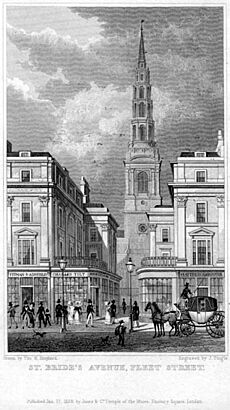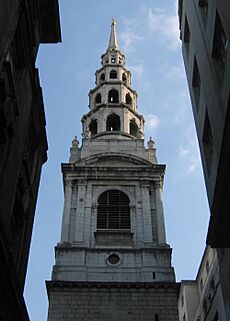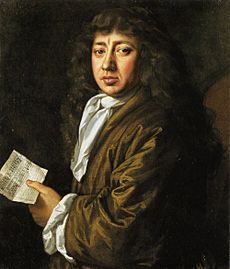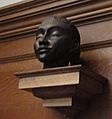St Bride's Church facts for kids
Quick facts for kids St Bride's Church |
|
|---|---|
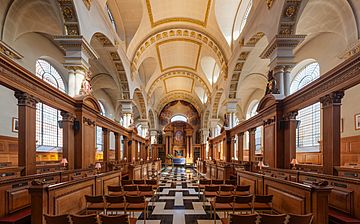
Interior of the church, as viewed from the nave looking east towards the altar.
|
|
| Location | London, EC4Y 8AU |
| Country | England |
| Denomination | Church of England |
| Architecture | |
| Heritage designation | Grade I listed building |
| Architect(s) | Sir Christopher Wren |
| Style | Baroque |
| Administration | |
| Diocese | London |
St Bride's Church is a famous Church of England church in Fleet Street in the City of London. It's thought to be named after Saint Bridget from Ireland, possibly as early as the 6th century. The church you see today was designed by the famous architect Sir Christopher Wren in 1672.
Sadly, much of Wren's church was badly damaged by fire during the London Blitz in 1940. But don't worry, it was carefully rebuilt in the 1950s to look just like the original. Because it's on Fleet Street, St Bride's has a long history with journalists and newspapers. Its tall steeple, which is 226 feet (69 meters) high, is a well-known part of London's skyline. It's the second tallest of all Wren's church spires, only shorter than St Paul's.
Contents
Church History
Ancient Beginnings
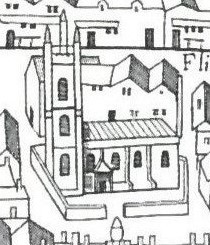
St Bride's might be one of London's oldest churches. People may have worshipped here since the 7th century. Its name likely comes from Bridget of Ireland, who is a patron saint of Ireland. Some believe Irish monks, who were missionaries, founded the first church around the 6th century. This makes it possibly the only church in eastern Britain founded by Irish Celts.
The current St Bride's is at least the seventh church built on this spot. The first church may have looked similar to an old church in Kildare, Ireland. A Norman church was built here in the 11th century. It was important for both religion and government. In 1210, King John even held a parliament meeting there. A larger church replaced it in the 15th century.
St Bride's became linked to the newspaper world in 1500. That's when Wynkyn de Worde set up his printing press right next door. For a long time, until 1695, London was the only city in England where printing was allowed by law.
The Roanoke Colony Connection
In the late 1580s, a woman named Eleanor White got married at St Bride's. Her father was the artist and explorer John White. Eleanor and her husband, Ananias Dare, had a daughter named Virginia Dare. Virginia was the very first English child born in North America! She was born on Roanoke Island on August 18, 1587.
A modern statue of Virginia Dare stands near the church's old font. This font is one of the few things that survived from the original church.
The Great Fire and Rebuilding
A big disaster happened in the mid-1600s. In 1665, the Great Plague of London caused many deaths. Then, in 1666, the church was completely destroyed during the Great Fire of London. This fire burned down a huge part of the city.
After the fire, the church was rebuilt by Sir Christopher Wren. It was one of his biggest and most expensive projects, taking seven years to finish. St Bride's reopened on December 19, 1675. The famous spire was added later, between 1701 and 1703. It was originally 234 feet tall. However, lightning struck it in 1764, making it eight feet shorter.
The idea for the wedding cake is said to have started in 1703. A baker's apprentice named Thomas Rich fell in love and wanted to make a special cake. He was inspired by the design of St Bride's Church for his extravagant cake.
Second World War Damage
On December 29, 1940, during the Blitz in World War II, fire-bombs hit the church. The Luftwaffe (German air force) dropped these bombs. That night, 1,500 fires started in London, causing huge damage. People called it the Second Great Fire of London. St Paul's Cathedral was saved only because brave firefighters and volunteers worked hard to stop the flames.
After the war, newspaper owners and journalists helped pay to rebuild St Bride's. The bombing had one unexpected good result. It allowed archaeologists to dig and find the church's original 6th-century Saxon foundations. Today, you can visit the crypt, which is called the Museum of Fleet Street. It has old items like Roman coins and medieval stained glass.
St Bride's Today
St Bride's Church was named a Grade I listed building on January 4, 1950. This means it's a very important historical building.
In 2007, the church started an appeal to raise money to preserve its unique history. In November 2007, Queen Elizabeth II attended a special service. This service celebrated 50 years since the church was restored after World War II. In 2012, another appeal was launched to fix the crumbling stonework of the church's famous spire.
In March 2016, the wedding of Jerry Hall and Rupert Murdoch took place at St Bride's.
Music at St Bride's
The Choir
The church choir has 12 adult singers. They sing at two services every Sunday throughout the year. They also perform for many special services. The Director of Music is Robert Jones, and the Assistant Director of Music is Matthew Morley.
The Organ
The organ at St Bride's was built by the John Compton Organ Company. It's considered one of their best works. The organ was ready for the church's reopening in November 1957. It has recently been fully checked and cleaned. The organ has four keyboards, 98 different sounds (called "speaking stops"), and almost 4,000 pipes!
Organists
Many talented musicians have been organists at St Bride's over the years. Here are a few:
- Henry Lightindollar (1696–1702)
- John Weldon (1702–1736)
- Samuel Howard (1736–1782)
- Gordon Reynolds (1952–1965)
- Robert Harre-Jones (from 1988)
The Bells
St Bride's Church is famous for its bells. It was the first place where a "full peal" was rung on twelve bells. Ten bells were made for the church in 1710. Two more were added in 1719, making it twelve.
Sadly, all the bells were destroyed during the Blitz in 1940. After the war, one new bell was placed in the tower. It weighs about 760 kilograms and is in the key of F♯. This bell was installed so that more bells could be added in the future to make a full set of twelve again.
Famous People Connected to St Bride's
Many famous people have been connected to St Bride's. These include writers like John Milton and John Dryden. The famous diarist Samuel Pepys was also baptized in the church. Pepys even buried his brother Tom there in 1664. The church vaults were so full that Pepys had to pay the gravedigger extra to make space! More recently, Sir Clement Freud's funeral was held at the church in 2009.
Notable Burials in the Churchyard
Some important people are buried in the churchyard of St Bride's:
- Richard Lovelace, a poet
- Denis Papin, who helped invent the steam engine
- Samuel Richardson, a novelist
- Thomas Weelkes, a composer
Images for kids
-
John Milton, a parishioner of St Bride's
-
John Dryden, a parishioner of St Bride's
-
Replacement memorial to Virginia Dare, the first child of English parents born in North America.
-
Marble sculpture of Virginia Dare formerly in St Bride's, which was stolen in 1999.
-
Samuel Richardson, buried in St Bride's
See also
 In Spanish: Iglesia de Santa Bride para niños
In Spanish: Iglesia de Santa Bride para niños
- Bridewell Theatre
- List of Christopher Wren churches in London
- St Bride Library



